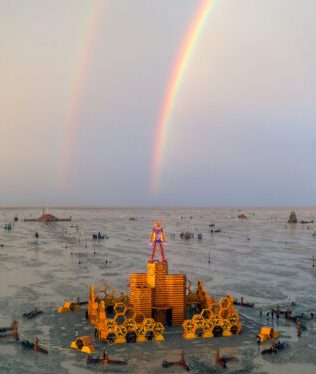
The transitory city that claims to “leave no trace” has left more than just a trace on the environment and the 70,000 people stranded there.
Every year, thousands upon thousands of people travel from all over the world to Black Rock Desert, Nevada, for one single notorious event: Burning Man. The premise of the event is that the people who travel there—the self-proclaimed “burners”—build up a makeshift city and stay there for about nine days; they are forced to be entirely self-reliant, bringing their own food and water to survive.
At the end of those nine days, they watch as the infamous burning man statue is burned down, signifying the end of their gathering. In between, the burners party, look at the art installations created, and barter—all the while following the event’s key principles including, but not limited to, radical self-expression, radical inclusion, and leaving no trace.
Seeing as the entire concept of Burning Man is to create a temporary city in a short span of time, and it is no surprise when things go awry, this year was no exception.
From the very beginning of this year’s event, Burning Man was destined for failure.
In order to enter the event area, there is one road for everyone to get in and out, meaning it can take more than five hours to enter the vicinity. However, when Burning Man opened their gates for all to enter, a 27-foot trailer awaited the people entering in protest of the event’s adverse effects on the climate, stalling the time even further.
According to NBC News, the event has released an estimated 100,000 tons of carbon dioxide, equivalent to the amount of carbon dioxide released into the atmosphere from the electricity usage of 19,000 homes.
Even so, to not acknowledge the fact that burners believe in “leaving no trace,” meaning to leave with all that they enter with—including their trash—would be wrong; however, to paint the event out to be a totally green, sustainable event would be a lie.
Eventually, all the burners were let in, but so was their untimely guest: rain.
In the week that Burning Man took place, the Black Rock Desert got the amount of rain that it typically receives in about three months; the exact effects that the climate change protesters had claimed that Burning Man was contributing to had come back to prove its point.
In turn, the playa that the event took place on turned into a thick mud. As a result, walking around the area became a grueling task, making driving out of the area an unlikely possibility.
70,000 people were left stranded—with only the food, clothes, and water they had brought on their backs to survive.
As the days trudged on by, thousands of people, including American DJ Diplo and comedian Chris Rock, took to walking to safety, leaving behind the vehicle that they had entered the event with. Still, many decided to stay on their now-extended trip to watch the traditional burning of the statue.
Now that the event has finally concluded those who left early are forced to deal with getting their stranded vehicles back and anything else that they may have left in the wake.
To say the Burning Man left no trace behind would be a lie; It has left a strong impression on the planet.



























































































